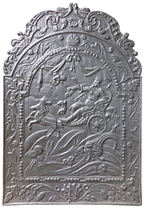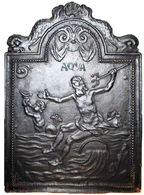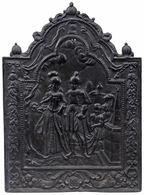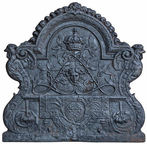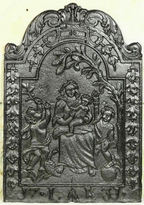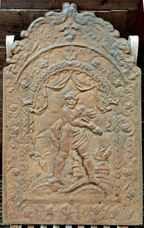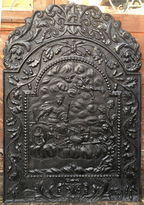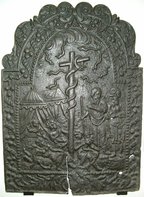-
904
Description: Arched rectangular shaped central panel with five-bead and open pellet edging; pictorial: regal figure in his chariot drawn by two horses, a sceptre in his right hand; above, a putto descends from swagged curtains and a pair of tassels; below is a landscape with a cornucopia; arched rectangular shaped border with fillet edging, a scallop shell top centre with symmetrical arrangement of ivy and acanthus leaves and tendrils; the initial, N, in a cartouche bottom centre, between symmetrical oak fronds, leaves and acorns; above is a symmetrical design of scrolled floral tendrils terminating in sea monsters.
Notes: Very similar in design and execution to firebacks of the SHR and EB series, suggesting designs emanating from the same source and with a similar inspiration. The figure in the chariot may be an allegory of the Sun.
Inscription: N
- Decoration tags:
- 'Dutch' (shape)
- fillet (edging)
- whole carved pattern
- allegorical
- animals
- humans
- plants
- objects
Manufactured: in the early-18th century in England.
Current location: not known.
- Attached to series:
- N series
- British 'Dutch' style firebacks
-
905
Description: Canted rectangle; fillet edging (top and sides); date to full width across centre of plate.
Notes: Bold, evenly-spaced numerals.
Inscription: 1680
- Decoration tags:
- rectangular with canted top corners (shape)
- fillet (edging)
- individual numbers
- text
Manufactured: in 1680 in England.
Current location: in private hands, Vauxhall, London, England.
- Attached to series:
- Date only firebacks
- 1680s Canted series
-
947
Description: Arched rectangular shaped central panel with bead edging; naked figure of Poseidon/Neptune holding a a trident in his raised left hand, his right arm extended; he is sitting on a bridge over a flowing stream; to his right a merman, half immersed, blows a shell trumpet; above centre, is the word AQUA (water - Latin); above is a swag of drapery enclosing a scallop shell; outside the panel is a narrow border of the same shape with fillet edging; the fireback is surmounted by a scallop shell between two outward-facing sea serpents.
Notes: One of a series of four designs of the classical elements of Earth, Air, Fire and Water.
Copies of this fireback are known.
Inscription: AQUA
- Decoration tags:
- 'Dutch' (shape)
- fillet (edging)
- whole carved pattern
- pictorial
- mythological
- allegorical
- text
- humans
- objects
Manufactured: in the mid- to late-17th century possibly in the Siegerland area of Germany.
Current location: not known.
- Attached to series:
- 'Dutch' Miscellaneous Firebacks
- Elements firebacks
-
984
Description: Arched rectangular central panel with additional arch above; bead and fillet edging; pictorial scene of, on the left, a tree next to a female and, in the centre, a male figure, both in eastern dress, a page behind holding a train, and to the right a short obelisk surmounted by a crescent, behind which is the head of a figure with a camel; behind is a small building also surmounted by a crescent, with clouds above; the word, ASIA, is centre bottom; identical shaped border with cavetto-moulded edging; a pomegranate on top with descending swags of drapery; at the sides, overlapping bunches of foliage suspended from ribbon bows; at the bottom, a central cartouche between fruit bunches; on top, a pomegranate with a descending serpent on each side, and a pomegranate on each shoulder of the plate.
Notes: A pastiche of the EUROPA design based on an engraving c.1642 of Friedrich Wilhelm, Elector of Brandenburg, and his wife, Luise Henriette of Oranje-Nassau, by Mathias Czwiczek, with the figures adopting very similar poses in an oriental setting; one of series depicting allegories of the four continents, in this instance Asia. A recasting.
Copies of this fireback are known.
Inscription: ASIA / MB
- Decoration tags:
- 'Dutch' (shape)
- fillet (edging)
- whole carved pattern
- pictorial
- allegorical
- monogram
- text
- animals
- humans
Manufactured: in the mid- to late-17th century possibly in the Siegerland area of Germany.
Current location: not known.
- Attached to series:
- 'Dutch' Arched arch types
- 'Dutch' Continents firebacks
-
990
Description: Complex quasi-arched rectangular shape with fillet edging; bell flowers descending from the top of the arch; double fillet scrolls at the side with cockerel terminals; under the arch, a royal crown surmounting a counter-posed double 'L' monogram enclosing a human mask with a sunburst; below, a table draped with a cloth bearing a circular royal shield of France within palm leaves.
Notes: A very elaborate and symbolic design alluding to the Sun King, Louis XIV.
- Decoration tags:
- rectangular with round arch (shape)
- fillet (edging)
- whole carved pattern
- architectural
- monogram
- humans
- plants
Manufactured: in the late-17th to early-18th century in France.
Current location: not known.
- Attached to series:
- Foreign armorial firebacks
-
989
Description: Arched rectangular shape with fillet edging; within an arched rectangular border alternating repeated acanthus leaves, and a floral cartouche, a heart-shaped shield of the royal arms of France, surmounted by a royal crown and within splayed olive branches.
Arms: France Royal
- Decoration tags:
- rectangular with round arch (shape)
- fillet (edging)
- whole carved pattern
Manufactured: in the late-17th century in France.
Current location: not known.
- Attached to series:
- Foreign armorial firebacks
-
1017
Description: Arched rectangular central panel with fillet edging; central seated female with an infant in her arms, a swan at her feet and a standing child on each side, the one to her left facing the front and holding aloft a flaming heart, its foot on a ball; the child to her right facing the woman, holding aloft a branch in its left hand, all on a ground with an overhanging tree to the right; arched rectangular border with fillet edging with descending festoons of acanthus flowers on each side, the date and initials at the bottom and, at the top on each side, a pair of acanthus flowers descending from a heart-shaped terminal of a strapwork frame; above, mirrored swirls of foliage.
Notes: The central pictorial scene is a crude pastiche of a panel portraying an allegory of Charity frequently used on firebacks produced in the Siegerland of north-west Germany for the Dutch market in the second half of the seventeenth century. The swirled foliage on the top is typical of English 'Dutch' style firebacks of the early-eighteenth century and the numerals are also more typically English in style.
Inscription: 17 . IAK[?] 31
- Decoration tags:
- 'Dutch' (shape)
- fillet (edging)
- whole carved pattern
- individual letters
- individual numbers
- allegorical
- text
- humans
- plants
Manufactured: in 1731 in England.
Current location: not known.
- Attached to series:
- Charity firebacks
- British 'Dutch' style firebacks
-
164
Description: Arched rectangular shaped central panel with hollow bead edging; draped male figure standing on undulating ground with two small trees, holding a bar, flaming furnaces behind, drapery suspended from above; Arched rectangular shaped border with fillet edging; swirled flowers and tendrils symmetrically arranged, with monogram at centre bottom; symmetrical arrangement of foliage on top.
Notes: The figure is of Pluto, one of a set of 'Eight Deities' engraved by Hendrick Goltzius (1592), after Polidoro da Caravaggio; a recasting, there is a larger (420mm x 640mm) but more corroded version in Hastings Museum. The faint initials SHR are probably those of the pattern-maker. The image is of a copy; original castings are fractionally larger.
Copies of this fireback are known.
Inscription: SHR
- Decoration tags:
- 'Dutch' (shape)
- fillet (edging)
- whole carved pattern
- mythological
- monogram
- humans
Manufactured: in the late-17th to early-18th century in England.
Current location: not known.
- Attached to series:
- SHR series
- British 'Dutch' style firebacks
- Eight Deities series
-
1059
Description: Arched rectangular central panel with bead on broad fillet edging; pictorial scene of a figure in a chariot on left, drawn across clouds by two peacocks; above, a putto and a bird flying in clouds; to the right, a tree; arched rectangular border with fillet edging; symmetrical undulating oak fronds descending from a loop; at the bottom, the letter W in a cartouche between swirled foliage; on top, mirrored swirled foliage descending from a loop.
Notes: The figure is likely to be that of Hera/Juno, who is traditionally associated with peacocks. The initial 'W' probably identifies the pattern maker; a single vertical line right of centre indicates the join between two boards that formed the pattern. The 'W' initial probably denotes the pattern maker.
Inscription: W
- Decoration tags:
- 'Dutch' (shape)
- fillet (edging)
- whole carved pattern
- planklines
- pictorial
- allegorical
- text
- humans
- plants
- objects
Manufactured: in the late-17th to early-18th century in England.
Current location: not known.
- Attached to series:
- British 'Dutch' style firebacks
- W series
-
726
Description: Arched rectangular central panel with bead-on-fillet edging; pictorisl scene of a central cross-shaped pillar entwined with a snake; two pavilions to the left with human figures lying before them; two standing figures to the right, one holding a staff; above, clouds with snakes descending from the sky; arched rectangular border with fillet edging; on each side, descending festoons of fruit entwined with ribbon; at the bottom, a central cartouche between palm fronds; on top, foliate swirls.
Notes: The scene is an illustration of the plague of serpents visited upon the children of Israel by God (Numbers 21: 6).
Copies of this fireback are known.
Manufactured: in the mid-17th century possibly in the Siegerland area of Germany.
Current location: Victoria & Albert Museum, Cromwell Road, Kensington & Chelsea, Greater London, England.
Museum number: 291-1893 (part of the Victoria & Albert Museum museum group)
Citation: Anon., 2 Dec 1905, 'Old Kent and Sussex Fire-backs', Country Life, pp. 767-768.
- Attached to series:
- 'Dutch' Miscellaneous Firebacks
- Old Testament & Apocrypha firebacks
